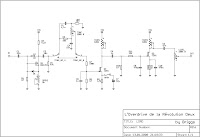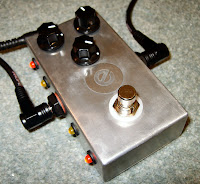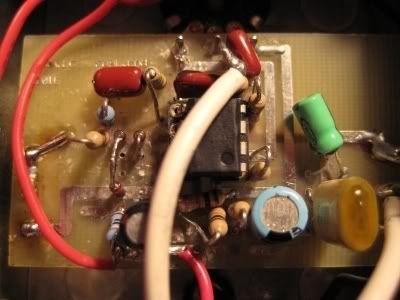-EDIT-
A few people have asked me what the LORD sounds like, I'd say like a cross between a Marshall and a Mesa, it can get slightly higher gain than a standard Marshall but not quite as hot as a Mesa on 10!
--EDIT 2--
Try running the LORD at 9v, 12v and 18v for a nice variation in sounds. The higher the voltage the more 'open' and less compressed the tone gets. The higher voltage also makes the circuit even more touch responsive!
As you can see the basic circuit structure is a mosfet gain stage running into two cascaded Jfet stage with a tone control in between the mosfet and jfet stages. I placed the tone control here because I wanted it to alter the harmonic structure of the clipping fet stages. You can really alter the sound of the LORD by modding the tone section, it's worth playing with.
***DISCLAIMER***
The LORD is not a subtle sounding pedal when at full gain. Windows will rattle, ears will sear and any neighbors/front row audience will lose any fillings they posess. At lower gains the LORD can be used to get subtle breakup or just to boost your signal - the choice is yours the LORD is your tool.
1) The Schematic
 First is the updated scheme. In my build I used a 100n cap on the source of the first fet and I used the "alt tonestack". I also added a "voice" switch which adds in a 4.7n cap across the 4.7n output cap I used for the mosfet stage (instead of the 10n stated), it essentially changes the bass response of the circuit from stock to what I call "thin".
First is the updated scheme. In my build I used a 100n cap on the source of the first fet and I used the "alt tonestack". I also added a "voice" switch which adds in a 4.7n cap across the 4.7n output cap I used for the mosfet stage (instead of the 10n stated), it essentially changes the bass response of the circuit from stock to what I call "thin".You may want to tweak the caps about a bit to suit your gear. Alter the high frequency roll off points at the two Jfet stage e.t.c, experiment - play until it sounds how you like it!
2) The Breadboard
 Here's the little sucker on the breadboard, testing was completed and confirmed that the little bugger made one hell of a racket - mission accomplished! (Note the cigarette burns on the carpet! Ooops!)
Here's the little sucker on the breadboard, testing was completed and confirmed that the little bugger made one hell of a racket - mission accomplished! (Note the cigarette burns on the carpet! Ooops!)3) The Enclosure
 I decided that "L'Overdrive de la Revolution Deux" needed a special enclosure (Read as; I was skint and didn't want to spend any cash buying a new hammond case!) I took the case from an old bust Ibanez phaser and modified it to my tastes.
I decided that "L'Overdrive de la Revolution Deux" needed a special enclosure (Read as; I was skint and didn't want to spend any cash buying a new hammond case!) I took the case from an old bust Ibanez phaser and modified it to my tastes.4) The Enclosure Continued
 A quick picture of the innards in place, you can see the squeeze I got into, having to slot that 3PDT in there was almost an error. The original footswitch will be used as a little "bonus feature" 8) Note the tone bypass switch and the voice switch (which is lying at the side of the enclosure!)
A quick picture of the innards in place, you can see the squeeze I got into, having to slot that 3PDT in there was almost an error. The original footswitch will be used as a little "bonus feature" 8) Note the tone bypass switch and the voice switch (which is lying at the side of the enclosure!)5) The Circuit
 I decided, for the extra mojo, to build the circuit point-to-point on perfboard. Here it is, layout completed and ready for the wires to go on! Note the two trim pots used for biasing the FET's to the correct voltage - very important!
I decided, for the extra mojo, to build the circuit point-to-point on perfboard. Here it is, layout completed and ready for the wires to go on! Note the two trim pots used for biasing the FET's to the correct voltage - very important!6) Wiring and Test

After I wired all the controls in place I fired the circuit up for debugging, as usual there was no errors at all :wink: All of the wiring was kept as short and neat as I could be arsed with!
7) Installation
 Next I had to install the circuit into the enclosure. Nice and neat :wink:. There is a prize for the first person who can tell me what I used the original footswitch for!? I was going to put a battery connector in there but I couldn't be bothered - I don't have any spare batteries, aparently we need those for the "Smoke Alarm".... Pfffft.
Next I had to install the circuit into the enclosure. Nice and neat :wink:. There is a prize for the first person who can tell me what I used the original footswitch for!? I was going to put a battery connector in there but I couldn't be bothered - I don't have any spare batteries, aparently we need those for the "Smoke Alarm".... Pfffft.8) All Finished
 Looking Good!
Looking Good! Still looking good.
Still looking good.
So there it is, the finished article. One hell of an overdrive :wink:
Give it a try, you wont be dissapointed - "L'Overdrive de la Revolution Deux" is a crowd killer! Please, if you do build it, be sure to give feedback on how it sounds - what gear you are using it with etc....
Marshmellow over at Freestompboxes was kind enough to layout a PCB for the LORD project. If you want to use the alt tonestack, as I did in my build, you can easily make the slight changes that you need to!




Here is a great vero layout done by the vero master - Torchy! Thanks so much for this Torch!






























